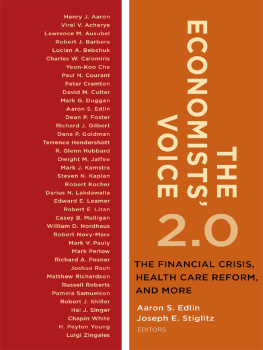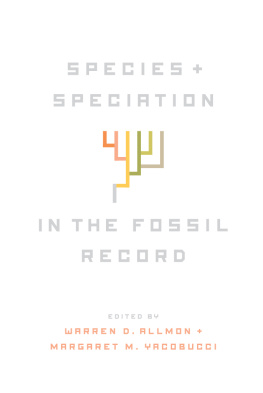THE ECONOMISTS VOICE 2.0
THE ECONOMISTS VOICE 2.0
The Financial Crisis, Health Care Reform, and More
Aaron S. Edlin
Joseph E. Stiglitz
EDITORS
Bradford DeLong
William Gale
James Hines
Jeffrey Zwiebel
COEDITORS
Columbia University Press
New York
Columbia University Press
Publishers Since 1893
New York Chichester, West Sussex
cup.columbia.edu
Copyright 2012 Columbia University Press
All rights reserved
E-ISBN 978-0-231-50432-4
Library of Congress Cataloging-in-Publication Data
The economists voice 2.0 : the financial crisis, health care reform, and more / editors, Aaron S. Edlin, Joseph E. Stiglitz ; coeditors, Bradford DeLong [et al.]
p. cm.
Includes bibliographical references and index.
ISBN 978-0-231-16014-8 (cloth : alk. paper) ISBN 978-0-231-50432-4 (ebook)
1. United StatesEconomic conditions20092. United States
Economic policy20093. EconomicsUnited States. I. Edlin, Aaron S. II. Stiglitz, Joseph E. III. DeLong, J. Bradford.
IV. Economists voice.
HC106.84E38 2012
330.973dc23
2011047626
A Columbia University Press E-book.
CUP would be pleased to hear about your reading experience with this e-book at .
References to Internet Web sites (URLs) were accurate at the time of writing.
Neither the author nor Columbia University Press is responsible for URLs that may have expired or changed since the manuscript was prepared.
Contents
Chapin White is a Senior Health Researcher at the Center for Studying Health System Change (HSC). He was an analyst at the Congressional Bud get Office (CBO) from 2004 through 2010 and was one of the lead analysts working on the scoring of the health care reform bill. The analysis and conclusions expressed in this chapter are the authors alone and should not be interpreted as those of the CBO or HSC.
THE AFFORDABLE CARE ACT (ACA) represents the most significant overhaul of our health care system since the establishment of Medicare and Medicaid. The ACA does two things: First, it fundamentally shifts the social contract in the United States. Starting in 2014, individuals will be required to have health insurance; in return, the federal government will significantly expand low-income health insurance subsidies. Second, it significantly rebalances the financing for Medicare by reducing the growth in outlays and increasing Medicare taxes paid by high earners.
This chapter provides non-specialists with a guide to the major provisions, their logic, and the federal budgetary implications. (All revenue and spending figures that follow refer to 10-year totals for FY 2010 to 2019 and are based on CBO and Joint Tax Committee estimates.)
MEDICARE
The ACA reduces Medicare outlays by roughly $400 billion. Two-thirds of this comes from reduced growth in the payment rates that medical providers receive in the traditional fee-for-service program (see ). Most of the rest comes from reductions in premiums paid to privately managed care plans. The payment rate reductionsroughly one percentage point a yearapply broadly to most types of medical ser vices, except for physicians (who have no reductions) and home health care agencies (which face disproportionately large cuts).
On the revenue side, the ACA raises Medicare hospital insurance (HI) taxes by over $200 billion. Starting in 2013, earnings above a cutoff ($200,000 for singles; $250,000 for couples) will be subject to an additional 0.9 percent tax, on top of the current 2.9 percent. Also starting in 2013, high-earning families will pay a new 3.8 percent HI tax on net investment income (interest, dividends, rents, and taxable capital gains). The ACA also raises the premiums that high-income Medicare beneficiaries will pay for physician and prescription drug coverage and reduces federal subsidies to hospitals that disproportionately serve low-income patients (DSH). Also, deductibles and coinsurance in Medicare Part D prescription drug plans (the donut hole) will shrink over the next decade, due to a combination of manufacturer discounts and additional federal financing.
The combination of reduced outlays and increased revenues substantially improves Medicares fiscal picture and pushes the Part A insolvency datethe year in which the Medicare Trustees project that the HI trust fund will be exhaustedfrom 2017 to 2029. The reduction in premiums paid to Medicare Advantage will likely lead those plans to raise premiums or cut benefits, which will cause some beneficiaries to shift out of those plans and back to the fee-for-service program.
TABLE 1.1
Summary of the Major Provisions in the ACA
| Effect on Federal Deficit (201019, $ billions) |
| Medicare Provisions |
| Reduced provider payment rates | 230 |
| Reduced premiums to private plans | 140 |
| Increased premiums for high-income beneficiaries | 40 |
| Close donut hole | 40 |
| New HI tax on high earners | 210 |
| Miscellaneous (DSH, IPAB, CMI, ACOs, bundling, etc.) | 50 |
| Net, Medicare Provisions | 610 |
| Coverage and Revenue Provisions |
| Medicaid expansion | 430 |
| Exchange credits | 460 |
| Small business credit | 40 |
| Tax on health insurers and manufacturers | 110 |
| Penalties on firms and individuals | 70 |
| Limit deductibility of health care expenses | 30 |
| Nonhealth revenue provisions | 50 |
| High-premium excise tax | 20 |
| Reduce Medicaid Rx prices | 40 |
| Miscellaneous (administrative simplification, high-risk pool, early retirees, etc.) | 30 |
| Net, Coverage and Revenue Provisions | 590 |
Note: This table excludes the off-budget effects of the ACA on the Social Security program and excludes the CLASS act and the education provisions in the ACA.
Rhetoric claiming that the ACA will accomplish more fundamental Medicare reform is generally overblown. For example, the new Independent Payment Advisory Board (IPAB) has been touted as the ACAs most important institutional change. The concept was to delegate to a body outside Congress the authority to make fiscally sound, but unpopular, changes to Medicare. But IPAB is highly constrained in its design. Its reforms are limited in nature (no rationing, no restricting benefits); in scope (hospitals and most other providers are off-limits until 2019); and in timing (IPAB can only make reforms if projected Medicare-spending growth exceeds a target growth rate). Crucially, IPABs target growth rateGDP per capita plus one percentage pointis unsustainably high, which essentially ensures that IPAB will not solve Medicares long-term financing problem.
Three other Medicare provisions have also received outsized attention:
Center for Medicare and Medicaid Innovation (CMI). The ACA expands the executive branchs authority to conduct demonstrations testing alternative payment and delivery systems in Medicare and Medicaid. How the CMI will play out is highly uncertain. The CBO projected that it would have essentially no impact on spending.
Accountable care organizations (ACOs). The concept behind ACOs is to encourage medical providers to form integrated systems and to incentivize those systems to reduce utilization while meeting quality benchmarks. But under the ACA, provider participation is purely voluntary, and incentives are one-sided: bonuses are available for ACOs that come in below a spending target, but there is no penalty for overshooting. Some ACOs will likely end up earning windfall bonuses due to the natural variability in health spending. The CBO guessed that, on the whole, ACOs would very modestly reduce Medicare spending, but those windfalls could very easily end up increasing it instead.










